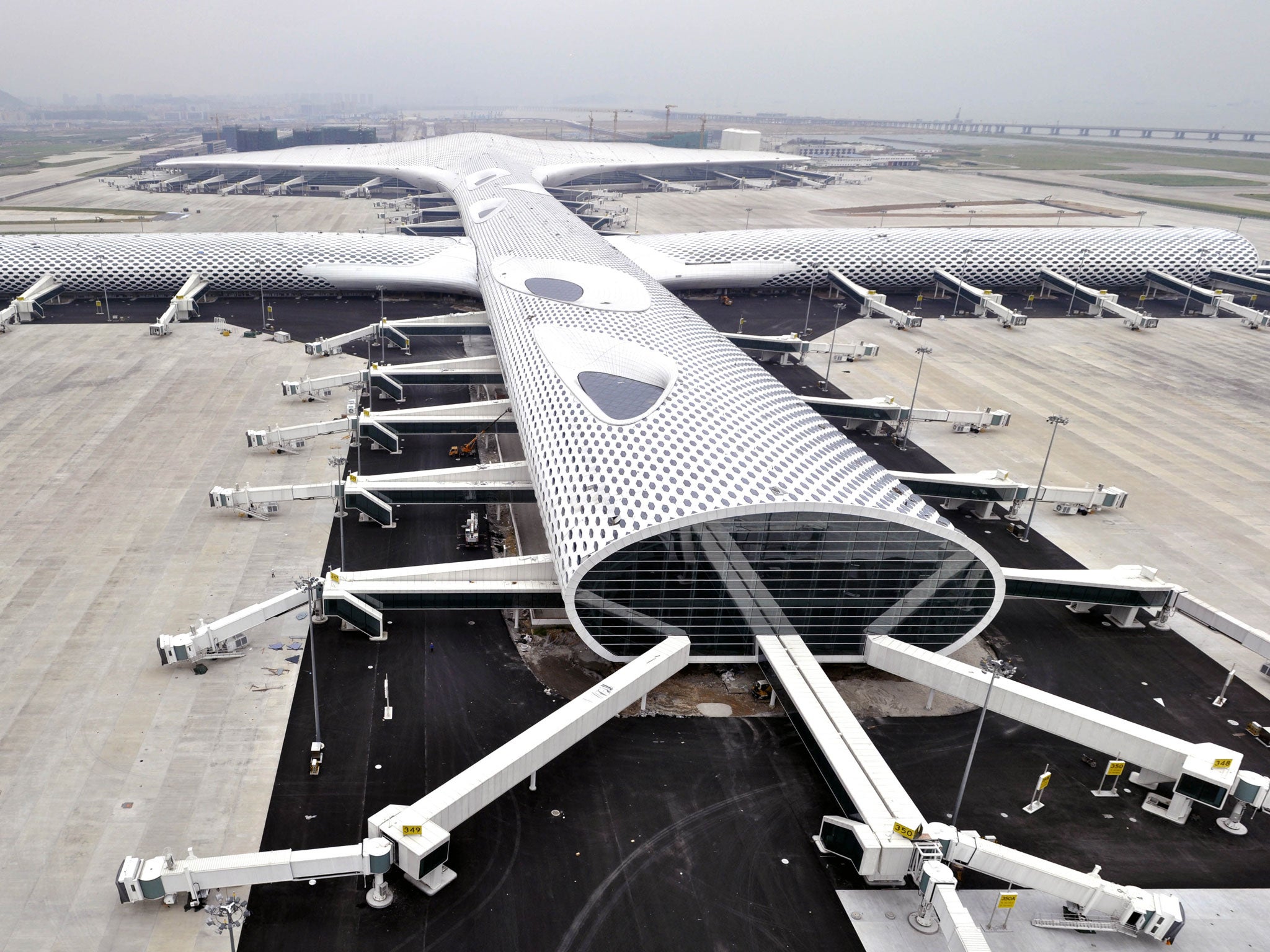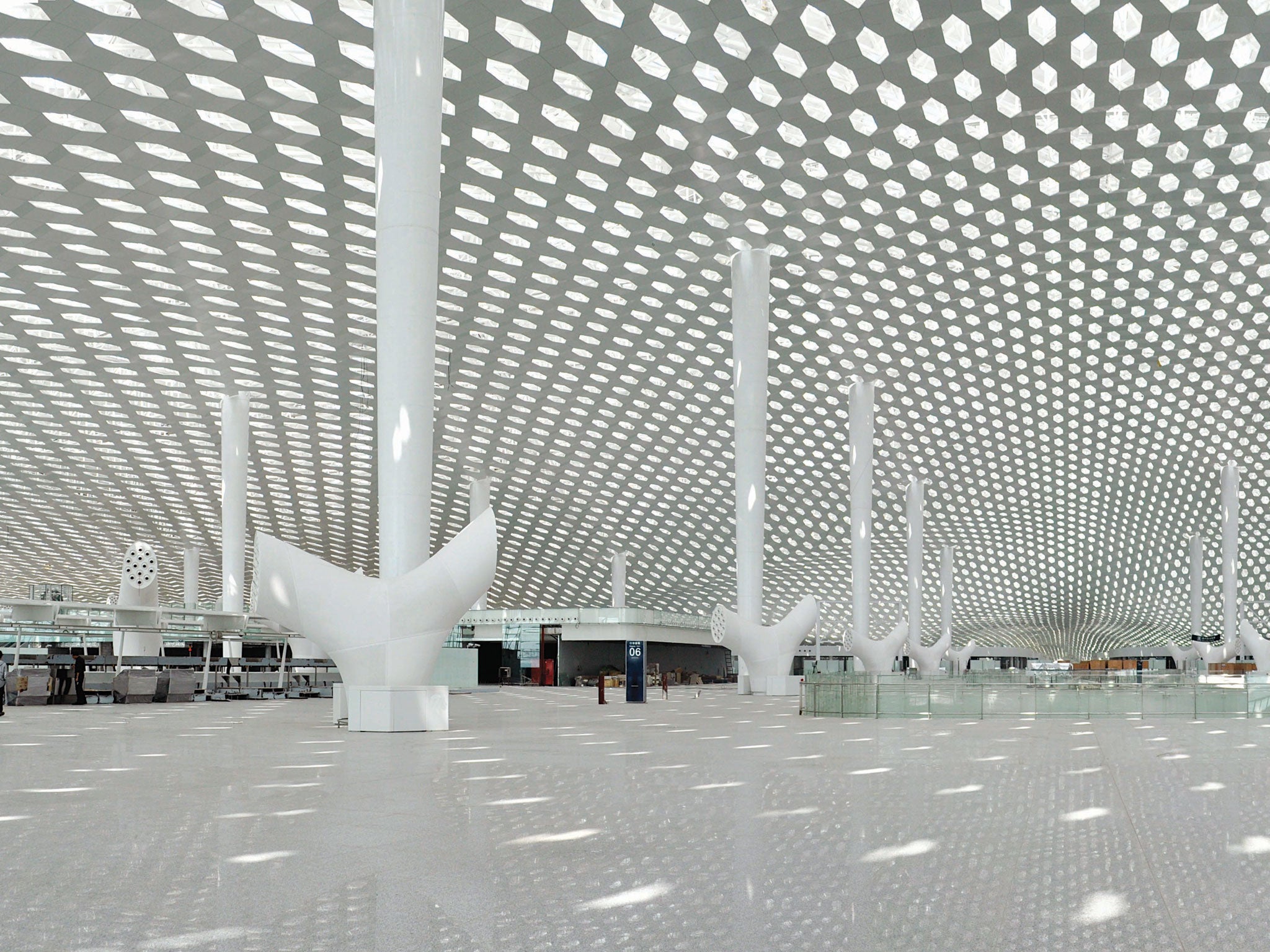Shenzhen airport Terminal Three: Vast, shiny, new - and empty? China's latest temple to aviation opens
It can handle 45 million passengers a year, 30 per cent more than Terminal Five. It cost $1bn (£612m), just one-seventh the cost of the Heathrow project. And while T5 had been 20 years in the making, the bigger Terminal 3 at Shenzen took only five.
Yet, despite also winning the plaudits of architects who hail its “cathedral-like scale”, T3 could prove to be one of the world’s biggest white elephants, judging from overseas airlines’ appetite for flying to the city, near Hong Kong.
As with Heathrow Terminal Five, Shenzhen’s new facility is experiencing teething problems. The planned Metro rail connection has not yet been extended to the airport. A longer-term concern, however, is the appeal of the airport’s location to airlines and their passengers.
The city, whose name translates as “deep drains”, is the border town adjacent to the New Territories of Hong Kong. It became a Special Economic Zone in 1980 while Hong Kong was still firmly in British hands. The city has grown rapidly, with a 30-fold increase in population to the present estimate of 11 million. Many are migrant workers from elsewhere in China, employed at hi-tech factories. Apple has two suppliers in the city, producing iPods and Mac books.
Among Shenzhen’s tourist attractions is a former Soviet aircraft carrier (complete with fighter jets) called Minsk World. Another is Dapeng Fortress, a battle site during the 19th-century Opium Wars against the “British colonial invaders”.
Unlike the largest Chinese cities, however, Shenzhen does not allow a visa-free stopover. Shenzhen airport’s website boasts a wide range of international destinations, including Dubai, Cologne and Sydney. But a trawl of sources, including airline websites and the aviation data specialist, OAG, failed to find any services to or from these airports.
Existing links seem to be purely regional, to cities such as Bangkok, Kuala Lumpur and Singapore, with additional destinations that China regards as “domestic” in the shape of Lhasa in Tibet and Taiwan’s capital, Taipei.
The sole US destination, Anchorage in Alaska, is served only by the cargo carriers UPS and Federal Express.
Neil Taylor, who pioneered travel to the People’s Republic with his company, Regent Holidays, said: “One has to wonder who will fly here from outside China, given the choice of flights to Hong Kong and to Macau, both actively promoted in the UK, both nearby and both visa-free. Shenzhen had its appeal as a small village when China first opened up in the late 1970s, but tour operators will find it hard to promote now.”

So what can Britain learn from China’s newest airport project? Given the differences in how the countries are run, it’s difficult to say.
The terminal, which has just opened, replaces the existing facilities with a structure of dramatic looks and huge capacity.
Shenzhen was the first airport project by the Rome-based architects, Massimiliano and Doriana Fuksas. Studio Fuksas says basic concept “evokes the image of a manta ray and features a striking internal and external double ‘skin’ honeycomb motif that wraps the structure”. From above, it resembles an aircraft complete with wings and a tailplane.
Features include stylised white “trees” that serve as air-conditioning vents. Glass panels punctuate the façade, allowing natural light to filter through. Artificial lighting was provided by an Edinburgh firm, Speirs and Major.
China has been developing its transport infrastructure at a phenomenal pace, building new airports and high-speed rail lines across the nation as its economy grows at a huge rate compared to the UK. The state directs big projects, and – unlike in Britain, where a third runway at Heathrow has been continually stymied – there is little effective local opposition.

It may serve as a warning to expanding airports when bigger competitors exist nearby. Shenzhen suffers from the proximity of Hong Kong airport, with which it has a ferry connection. Hong Kong handles twice as many passengers, with far more international destinations.
The biggest Chinese cities continue to attract new flights from Europe. Last week the French airline, Aigle Azur, announced a new link from Paris Orly to Beijing. But the expected surge of connections from Europe to large “secondary cities” in China has not materialised.
British Airways this year added a link from Heathrow to Chengdu, but elsewhere momentum has slowed. Finnair has shelved plans to increase services to Xian, while reports in the French press suggest that only heavy subsidies from the local Chinese authorities are sustaining the Air France link between Paris and Wuhan. Le Figaro claimed that the airline was rewarded with a €30,000 subsidy for every flight.
Join our commenting forum
Join thought-provoking conversations, follow other Independent readers and see their replies
Comments